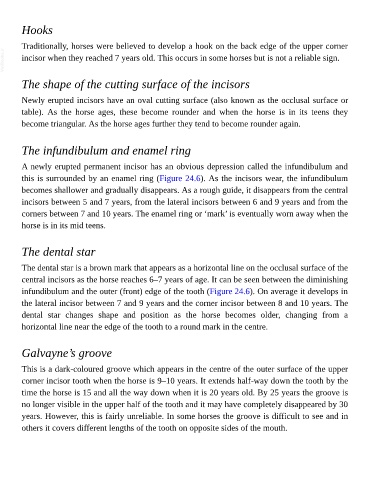Page 1065 - The Veterinary Care of the Horse
P. 1065
Hooks
Traditionally, horses were believed to develop a hook on the back edge of the upper corner
VetBooks.ir incisor when they reached 7 years old. This occurs in some horses but is not a reliable sign.
The shape of the cutting surface of the incisors
Newly erupted incisors have an oval cutting surface (also known as the occlusal surface or
table). As the horse ages, these become rounder and when the horse is in its teens they
become triangular. As the horse ages further they tend to become rounder again.
The infundibulum and enamel ring
A newly erupted permanent incisor has an obvious depression called the infundibulum and
this is surrounded by an enamel ring (Figure 24.6). As the incisors wear, the infundibulum
becomes shallower and gradually disappears. As a rough guide, it disappears from the central
incisors between 5 and 7 years, from the lateral incisors between 6 and 9 years and from the
corners between 7 and 10 years. The enamel ring or ‘mark’ is eventually worn away when the
horse is in its mid teens.
The dental star
The dental star is a brown mark that appears as a horizontal line on the occlusal surface of the
central incisors as the horse reaches 6–7 years of age. It can be seen between the diminishing
infundibulum and the outer (front) edge of the tooth (Figure 24.6). On average it develops in
the lateral incisor between 7 and 9 years and the corner incisor between 8 and 10 years. The
dental star changes shape and position as the horse becomes older, changing from a
horizontal line near the edge of the tooth to a round mark in the centre.
Galvayne’s groove
This is a dark-coloured groove which appears in the centre of the outer surface of the upper
corner incisor tooth when the horse is 9–10 years. It extends half-way down the tooth by the
time the horse is 15 and all the way down when it is 20 years old. By 25 years the groove is
no longer visible in the upper half of the tooth and it may have completely disappeared by 30
years. However, this is fairly unreliable. In some horses the groove is difficult to see and in
others it covers different lengths of the tooth on opposite sides of the mouth.

